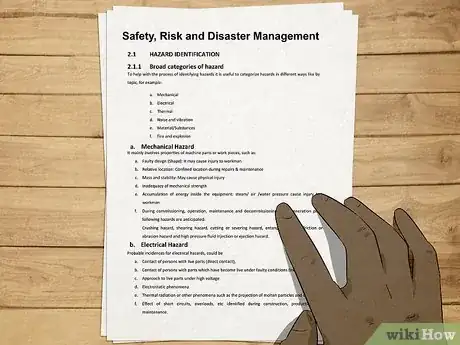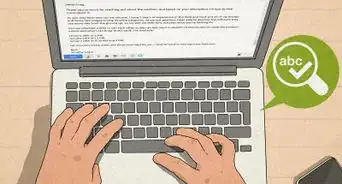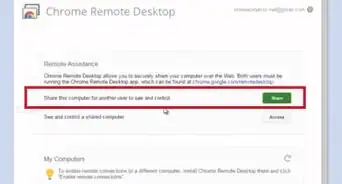This article was co-authored by Arda Ozdemir, MA. Arda Ozdemir is the Executive Coach and Founder of Rise 2 Realize, a nonprofit organization in Palo Alto, California that is dedicated to providing a practical roadmap toward one's full potential in their life and career. Arda is a Reiki Master, an Emotional Freedom Technique Practitioner, and a certified HeartMath Trainer and Mentor.
There are 10 references cited in this article, which can be found at the bottom of the page.
wikiHow marks an article as reader-approved once it receives enough positive feedback. In this case, several readers have written to tell us that this article was helpful to them, earning it our reader-approved status.
This article has been viewed 324,075 times.
Properly training newly hired employees is essential in any industry. Failure to provide adequate training can result in job dissatisfaction, low productivity, and staff turnover. From the basics, like offering a tour, to the training manual’s nitty gritty guidelines, staff training takes sensitivity and attention to detail. Above all, provide well-organized information, set the pace according to a trainee’s abilities, and have patience as they learn the swing of things.
Steps
Acclimating a New Employee
-
1Make sure they know where to park. It’s easy to overlook basic logistics, like parking. Provide them with directions to the parking lot, specify which lot to use, and let them know if they have a designated space. If necessary, provide parking stickers or other access passes.[1]
-
2Show them their workstation. Prior to their first day, make sure they have a desk, phone line, laptop, business cards, and other office essentials.[2] For non-office jobs, show them whatever location they’ll do most of their work.
- There’s nothing worse for a new employee than to worry about showing up early and making a great first impression, only to find their employer hasn’t prepared for their first day.[3]
Advertisement -
3Give them a thorough tour. Restrooms, supply closets, printer and copy stations, and the cafeteria are typical spots on orientation tours. Don’t forget the break room, coffee pot, and microwave. It might also be necessary to show them a first aid station, fire extinguishers, and other safety equipment.[4]
- Work with your department or company to come up with key places to include on the tour.
-
4Make sure they don’t eat lunch alone. Lunchtime is another detail that’s often overlooked. First days are tough, and nothing underscores being new more than eating lunch alone. Coordinate with your colleagues to make sure new hires can share a meal with friendly faces.[5]
-
5Assign a highly qualified trainer. Training duties are often assigned to employees with time on their hands or those whose desks are closest to that of the new hire. However, if you’re a training manager, you should take the lead. In addition, it’s wise to designate an experienced employee with excellent communication skills and a good bedside manner to assist with training.[6]
- That employee should do work similar to what the new hire does. They can also offer “unofficial” advice, such as how certain managers prefer to communicate or who throws the best holiday party.
Creating Training Materials
-
1Provide a clearly outlined training manual. A well-organized manual starts with an outline that previews its contents. It should then break down each topic into digestible chunks with a clear, logical order. A good structure introduces broad concepts first, presents more detailed information step by step, then briefly summarizes key points.[7]
- You should provide a printed manual so the trainee can take notes as they go. In addition, email them a digital copy of the training manual, employee handbook, and other materials. That way, they can always refer to the email if they don’t have the hard copies handy.[8]
-
2Include the job description and performance expectations. The training manual should also include a comprehensive job description that lists their essential duties, skills, and performance goals. It’s also helpful to include a performance review rubric so they clearly understand what the company expects of them.[9]
-
3Provide a staff overview and contact information. A company hierarchy flow chart will let trainees know how departments are structured, who their heads are, and who reports to whom. It’s also helpful to give trainees a list of people in their department. [10]
- Make sure they have all necessary contact info for anyone within or outside of the company (such as vendors or clients).
-
4Include any necessary information about safety standards. Depending on the industry, make sure the manual covers emergency procedures and safety standards. If necessary, check with the appropriate government agency, such the Occupational Safety and Health Administration (OSHA), to find out what your safety training needs to cover.[11]
-
5Don’t skip company culture and values. The manual shouldn’t just include information about day to day tasks. It should communicate the company’s history, values, vision, and goals. Remember, you don’t just want a body in a cubicle. You want someone who actively engages and represents the company culture.[12]
-
6Put together a list of company resources. Additional resources vary by industry, but might include annual reports, marketing materials, and old presentations. It’s wise to compile these on the company intranet or password-protected section on the website.[13]
- In order to prevent overwhelming them, let them know that these helpful resources are at their disposal, but not required reading.
Structuring a Training Schedule
-
1Take time to get to know a new hire as a person. Take the time to engage in conversation with the newcomer. Ask about their family, hobbies and interests, and don't forget to share your own.[14]
- Working in time in the schedule to get know the trainee will help ease their nerves and encourage them to become part of the team.
-
2Find the middle path between overwhelming and babying them. Start with a bird’s eye view of their job, then fill in details a little at a time. Dropping a thick manual on their desk and throwing them to the wolves is not the way to go. However, you shouldn’t go at a snail’s pace and read training protocols word by word either.[15]
- Schedule 5 to 10 minute breaks between topics to help them digest information without getting overwhelmed.
-
3Assign non-critical tasks and be ready to answer questions. First, make sure the trainee knows that they can ask you (or others in the department) for help if they need it. Then, have them complete tasks on their own based on what they’ve been trained to do. Let them know that they shouldn’t hesitate to ask for help if they run into problems.[16]
- Most people learn better by doing instead of listening. While you shouldn’t assign a task that will make or break the company, don’t ask them to do something menial. Show them that you have confidence in their abilities.
-
4Set the pace training according to a trainee’s abilities. Not everyone learns at the same pace, so try not to move on to a new training topic before the trainee is ready. Once they’ve gotten the hang of something, begin challenging them by giving them assignments with achievable goals.[17]
- Ask the trainee periodically if you’re going too fast or too slow. They might try to hide the fact that they’re lost, so do your best to read their body language.[18]
- A longer training period might take extra resources in the short term, but a thoroughly trained employee is worth a momentary dip in productivity.
Creating a Positive Training Experience
-
1Be generous with praise. Offering praise is essential if you want your new hire to gain confidence.[19] Instead of giving empty compliments, praise specific efforts and achievements.[20]
- For example, you might say, “You finished that assignment way ahead of schedule. I have to admit, I thought I’d find some errors when it came in so fast, but there were none to be found. Great job!”
-
2Offer constructive criticism when necessary. Never hesitate to point out when a trainee does something incorrectly. You’ll only do them a disservice and encourage a quick mistake to become a long-term bad habit.[21]
- If necessary, soften criticism by saying things like, “It would be easier if you did this,” or “Don’t worry - it’s an easy mistake to make.”
- More often than not, new hires want to hear constructive feedback sooner rather than later. Months down the line, you don’t want to leave an employee wondering why you didn’t correct their mistake earlier.[22]
-
3Give trainees time to get up to speed. Add responsibilities gradually, don’t come down too hard on mistakes, and continue to work on training even after they’ve completed the official training period. Every job and every person is unique, and the time it takes for someone to get into the swing of things will vary.[23]
- Depending on person and the industry, it could take up to a year to settle into a new job.
-
4Gather feedback about the training process. A good training program is always in development. Once they’ve finished training, ask the new hire if they suggest any ways to improve. Ask if they’ve run into something training didn’t cover, whether it was too fast or slow, and if they would change anything about its structure.[24]
Expert Q&A
-
QuestionHow can I make employees more engaged at work?
 Arda Ozdemir, MAArda Ozdemir is the Executive Coach and Founder of Rise 2 Realize, a nonprofit organization in Palo Alto, California that is dedicated to providing a practical roadmap toward one's full potential in their life and career. Arda is a Reiki Master, an Emotional Freedom Technique Practitioner, and a certified HeartMath Trainer and Mentor.
Arda Ozdemir, MAArda Ozdemir is the Executive Coach and Founder of Rise 2 Realize, a nonprofit organization in Palo Alto, California that is dedicated to providing a practical roadmap toward one's full potential in their life and career. Arda is a Reiki Master, an Emotional Freedom Technique Practitioner, and a certified HeartMath Trainer and Mentor.
Career & Life Coach Play to their strengths and interests. If one employee really hates making spreadsheets but another employee is interested in technical analysis, give the second employee next month's quarterly reports. If an employee can't sit still, have them carry out the tasks that involve moving around a lot. If you can find a way to get your employees interested in their work, they're going to be naturally more engaged in what they're doing.
Play to their strengths and interests. If one employee really hates making spreadsheets but another employee is interested in technical analysis, give the second employee next month's quarterly reports. If an employee can't sit still, have them carry out the tasks that involve moving around a lot. If you can find a way to get your employees interested in their work, they're going to be naturally more engaged in what they're doing. -
QuestionWhen do you know the employee isn't going to learn the task properly? How long should you give it?
 Community AnswerNew employees should be trained properly at the commencement; this is the time to observe and spot errors being made and correct them. While each employee learns at their own pace, the amount of time to give them should depend on how much experience they promised you they had in their interview/CV combined with the average time your industry expects the person to come up to scratch. The harder the task/knowledge, the longer the time needed. The most telling signs an employee isn't working out include ongoing incompetence, reticence to ask questions when stuck and passing tasks off to coworkers frequently.
Community AnswerNew employees should be trained properly at the commencement; this is the time to observe and spot errors being made and correct them. While each employee learns at their own pace, the amount of time to give them should depend on how much experience they promised you they had in their interview/CV combined with the average time your industry expects the person to come up to scratch. The harder the task/knowledge, the longer the time needed. The most telling signs an employee isn't working out include ongoing incompetence, reticence to ask questions when stuck and passing tasks off to coworkers frequently. -
QuestionHow do I train staff to provide the highest quality, most cost effective services?
 Community AnswerBe a leader, not a boss. Some of the best managers are those who acknowledge that they may not be the smartest people in the room. Hence, they always listen, keep an open mind and never stop learning.
Community AnswerBe a leader, not a boss. Some of the best managers are those who acknowledge that they may not be the smartest people in the room. Hence, they always listen, keep an open mind and never stop learning.
References
- ↑ https://humanresources.ku.edu/preparing-your-new-hire
- ↑ https://hbr.org/2015/05/how-to-get-a-new-employee-up-to-speed
- ↑ https://www.forbes.com/sites/jeffschmitt/2013/08/08/12-ways-to-alienate-a-new-hire/#42cc7c9c3ecc
- ↑ https://www.themuse.com/advice/5-tips-for-training-new-hires
- ↑ https://www.themuse.com/advice/5-tips-for-training-new-hires
- ↑ http://www.nfib.com/content/resources/staffing/bizhelp-7-tips-for-training-new-employees-71495/
- ↑ https://www.inc.com/alison-green/how-to-train-a-new-hire.html
- ↑ http://www.nfib.com/content/resources/staffing/bizhelp-7-tips-for-training-new-employees-71495/
- ↑ https://hbr.org/2015/05/how-to-get-a-new-employee-up-to-speed
- ↑ https://www.inc.com/alison-green/how-to-train-a-new-hire.html
- ↑ https://projects.ncsu.edu/project/feedmill/pdf/E_Employee_Training_Final_tagged
- ↑ http://www.nfib.com/content/resources/staffing/bizhelp-7-tips-for-training-new-employees-71495/
- ↑ https://www.themuse.com/advice/5-tips-for-training-new-hires
- ↑ https://hbr.org/2015/05/how-to-get-a-new-employee-up-to-speed
- ↑ https://www.forbes.com/sites/jeffschmitt/2013/08/08/12-ways-to-alienate-a-new-hire/#42cc7c9c3ecc
- ↑ https://www.inc.com/alison-green/how-to-train-a-new-hire.html
- ↑ http://www.businessinsider.com/why-its-crucial-to-train-your-employees-2010-5
- ↑ https://www.inc.com/alison-green/how-to-train-a-new-hire.html
- ↑ https://www.entrepreneur.com/article/239865#
- ↑ https://www.trainingjournal.com/articles/feature/power-praise-and-recognition
- ↑ https://www.entrepreneur.com/article/239865#
- ↑ https://www.forbes.com/sites/jeffschmitt/2013/08/08/12-ways-to-alienate-a-new-hire/#42cc7c9c3ecc
- ↑ https://hbr.org/2015/05/how-to-get-a-new-employee-up-to-speed
- ↑ http://www.nfib.com/content/resources/staffing/bizhelp-7-tips-for-training-new-employees-71495/
About This Article
With patience and a training manual, you can bring a new employee up to speed on their job requirements. Start by giving the employee a printout of the training manual so they can reference it and take notes as you show them the ropes. Give them a thorough tour of the building and show them where they’ll be working to get them acclimated. As you go through the job description in the training manual, make sure you go over any safety standards or company policies that they need to be aware of. Start them off on non-critical tasks like filing or data entry so they can get familiar with things. Be ready to answer questions as they navigate the job and praise them whenever they do something right to build their confidence. In time, they’ll be fully prepared for anything the job requires. For tips about how to give constructive criticism, keep reading!



















































































